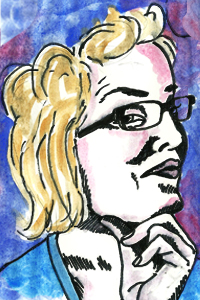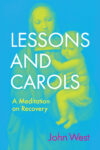I grew up believing that reality began and ended with what we felt inside. Nothing you could touch, not even your own body, was as real as what you could picture in your mind. Blanking out and disconnecting from reality was a kind of sacrament, a way of not having to challenge or reconcile the actual world with what I’d been taught to believe. “We create our own realities,” I was often told, with the kind of reverence that obliterates argument.
In my reality, then, the one that I was convinced of, I didn’t have a disability. My childhood physical therapists told my parents they’d never seen such stubbornness before. I denied what I could feel, what I could see, and I wasn’t nice about it either; I was a brat. I’m surprised I didn’t shatter full-length mirrors, take them out like I wanted to. I didn’t see my reflection as a reflection. It was an attack. So was any stranger’s acknowledgement of my cerebral palsy, from “Can I give you a hand with that?” to “Jesus will heal you, don’t worry.”
The body I wanted other people to recognize was the one I believed I had. That was the real one. The body I believed I had looked like all the bodies I saw and admired, with their easy and unwavering gaits.
Last month, former Spokane N.A.A.C.P. chapter president Rachel Dolezal told Matt Lauer, “I identify as black,” citing that at the age of 5 she was “drawing self-portraits with the brown crayon instead of the peach crayon.” Listening, I thought back to my own early self-portraits. I always drew myself standing up straight, unaided. I never felt comfortable in groups of kids that I was told were “like me,” born disabled. Like Dolezal, I insisted that what you could see of my body was contrary to who I actually was.
When political commentator and talk show host Melissa Harris-Perry asked Dolezal, “Are you black?” Dolezal answered, “Yes.” It was that simple; no qualifiers needed. This is who I am, her contented smile seemed to say. She, at least in her own mind, didn’t have to explain or justify her self-identification narrative.
Transgender writers and allies have been quick to champion self-identification narratives while simultaneously denouncing Dolezal’s made-up labels. “Rachel Dolezal identifies as black,” Meredith Tulsan writes in The Guardian. “But I am a woman.” Identification is different, then, from what we are. “Race,” Tulsan says, “is a social construction originally designed to separate and justify the subjugation of darker peoples for the purposes of European supremacy . . . But while society imposes a ton of social conditions on people because of their gender, those conditions are common across many societies and thousands of years.”
Tulsan’s understanding of race is accurate, but she doesn’t bother to explain why gender construction should be understood differently. Are these social conditions supposed to have a biological effect on the brain because of their reinforcement over time and across cultures? Science writer and research fellow Cordelia Fine debunks this view in Delusions of Gender, which details the flaws in the scientific studies that, up until now, have been cited in support of this misogynistic Victorian idea that there exists a “male brain” and a “female brain.”
Tulsan also implicitly argues that gender designation is inherently oppressive in part because it begins right away. “Doctors don’t announce our race or color when we are born,” she says, “they announce our gender.” Actually, the Center for Disease Control does record race on long-form birth certificates, drawing from an extensive list that includes such pithy racial categories as “coffee” and “rainbow.” Regardless, doctors announce a congenital disability even before birth, if they can. If we accept all self-identification narratives as more immediate than objective reality, then can’t I throw off the mantle of disability?
When one Guardian commenter wrote that they still didn’t see the difference between Dolezal’s sincere belief that she is black and Tulsan’s unshakable knowledge of herself as not a trans woman but a woman, one person responded: “Not remotely analogous. Come back when there is any genuine medical research to suggest that race dysphoria is a real thing. Then we’ll talk.”
Let’s talk, then, about ability dysphoria, which hasn’t been investigated by medical research because, as I understand it, it’s especially uncommon. How do you block out your own body, ignore your own limbs, indulge such a vivid mental picture of how you really look that any acknowledgement of your gait and its unusual rhythms can make you, for hours, feel disconnected and unreal?
It’s been patches of my whole life. If you add up the hours, I’ve likely lost months to this self-imposed condition. I see my body and I’m angry. Because I grew up with an understanding that feeling blissful was a form of worship and feeling uncomfortable a personal failure to understand the perfection in the Universe, the first thing I disconnect from is the anger. The anger makes my body real. But my body isn’t real, not this one. Look at the one that’s me.

Sarah Neilson is a freelance writer and editor currently living in Seattle. She writes a monthly column at Full Stop that explores America’s emotional condition.
Then I picture myself as I want to be, or someone tells me they don’t even notice the crutches, and I’m fine.
Should I ask you to learn to see me as non-disabled?
Or should I ask myself to reevaluate my own ideas of what being disabled has to mean? I thought that anyone who made it clear they found me attractive wasn’t seeing the crutches, or noticing how I walk. It never occurred to me that my sexuality and my CP coexisted comfortably, without one canceling the other out. Obviously, anyone who’s weird about disability — and plenty of people are — needs to be set straight on basic human respect.
So is the case with gender. Everyone deserves human respect, the right to live as who they are and express themselves as they see fit without fear of attack. But what does it serve to ignore acculturation, and deny that one set of ingrained cultural norms will have a different impact on later life than another? Why is trans woman considered a less respectful identity than woman? Race and gender are both absurd cultural constructs, created to justify oppression; anatomy is objectively evident. Ability as a cultural construct is murkier, but worth considering; there is no category of “disabled” without a fixed set of agreed-upon characteristics about what a “normal” person can do.
“I wish I could have had conversations with all kinds of people,” Dolezal told Vanity Fair writer Allison Samuels, reflecting on how she might have avoided a public “outing” last month. “I could have said, ‘O.K., so this is the case. This is who I am, and I’m black and this is why.’” She’s emphatic about the fact that she’s black, but she still hasn’t addressed the question of why, in spite of her documented heritage, she isn’t white. If she changed the conversation from her ill-defined “connection with the black experience” to a discussion about how being white contradicts who she really is, what kinds of assumptions about acculturation, behavior, and constrictions would we be seeing?
I’ll ask the same question about gender. If self-identification narratives centered not on what we know we are, but what we know we’re not, how might that help us dismantle assumptions about gender that limit our conceptions of what’s allowed, or even possible?
The words we use to refer to one another won’t necessarily influence how we actually behave. There’s no reason not to respect a person’s preferred pronouns, but there is also no reason to ignore the differences in conditioning between one gender and another, regardless of identification. I used to think that labels played an integral role in upending our categorical societal assumptions, and when I was 20 I coined a Latin-Dutch hybrid term that was supposed to replace disabled.
I proposed this idea to an online community called GimpGirls. Every one of them thought I was out of my mind. People’s perceptions of disability have nothing to do with language, they said. I understand their indignation now: It’s not how we refer to each other that matters. It’s the ideas we have about what’s permissible, or even commendable, for one person, and entirely off limits to another.
Knowing, as I now do, that I hadn’t even come close to accepting my disability at that time, I see that I was using words as a means of making other people affirm an idea of myself that, without constant outside reinforcement, would evaporate, and leave me alone with my own body. If self-acceptance is entirely internal, what does it matter how other people perceive us, as long as they treat us with respect? Why should anyone get to attach basic respect to a narrative that has to be accepted unquestioningly?
Rachel Dolezal proved, if nothing else, that self-identification narratives need to be challenged. If we accept them without question, we’ll never understand each other; self will come before reality, as I was taught that it should. Dolezal believes that, because she has identified as black from the age of 5 and has two black children, she understands the experience of being a black mother in America. We all know this is a lie, if not a delusion. But we’re reluctant to ask the same questions of someone who says they understand what it means to be treated as a woman.
I don’t understand what it means to be treated as non-disabled, but I do know when I’m being treated with respect. Why is this an appropriate baseline for some people, but an offensive one to ask of others? What are all these words for if not to establish what it means to respect another human being?
This is the problem with self-identification: It comes down, ultimately, not to respecting people, but to respecting me. Rachel Dolezal smiled on the world while demanding that we respect her, meaning that we see her as black, and understand her life as the life of a black woman. Respect, a humbling action, will never center on one person’s narrative of themselves. Respect demands that we understand ourselves in relationship to other people, not in a vacuum where we get to be right.
This post may contain affiliate links.







